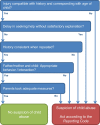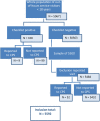The Value of a Checklist for Child Abuse in Out-of-Hours Primary Care: To Screen or Not to Screen
- PMID: 28045904
- PMCID: PMC5207629
- DOI: 10.1371/journal.pone.0165641
The Value of a Checklist for Child Abuse in Out-of-Hours Primary Care: To Screen or Not to Screen
Abstract
Objectives: To assess the diagnostic value of the screening instrument SPUTOVAMO-R2 (checklist, 5 questions) for child abuse at Out-of-hours Primary Care locations (OPC), by comparing the test outcome with information from Child Protection Services (CPS). Secondary, to determine whether reducing the length of the checklist compromises diagnostic value.
Methods: All children (<18 years) attending one of the participating OPCs in the region of Utrecht, the Netherlands, in a year time, were included. The checklist is an obligatory field in the electronic patient file. CPS provided data on all checklist positives and a sample of 5500 checklist negatives (dataset). The checklist outcome was compared with a report to CPS in 10 months follow up after the OPC visit.
Results: The checklist was filled in for 50671 children; 108 (0.2%) checklists were positive. Within the dataset, 61 children were reported to CPS, with emotional neglect as the most frequent type of abuse (32.8%). The positive predictive value (PPV) of the checklist for child abuse was 8.3 (95% CI 3.9-15.2). The negative predictive value (NPV) was 99.1 (98.8-99.3), with 52 false negatives. When the length of the checklist was reduced to two questions closely related to the medical process (SPUTOVAMO-R3), the PPV was 9.1 (3.7-17.8) and the NPV 99.1 (98.7-99.3). These two questions are on the injury in relation to the history, and the interaction between child and parents.
Conclusions: The checklist SPUTOVAMO-R2 has a low detection rate of child abuse within the OPC setting, and a high false positive rate. Therefore, we recommend to use the shortened checklist only as a tool to increase the awareness of child abuse and not as a diagnostic instrument.
Conflict of interest statement
The authors have declared that no competing interests exist.
Figures





Similar articles
-
Development of screening tool for child abuse in the korean emergency department: Using modified Delphi study.Medicine (Baltimore). 2018 Dec;97(51):e13724. doi: 10.1097/MD.0000000000013724. Medicine (Baltimore). 2018. PMID: 30572510 Free PMC article. Review.
-
A screening protocol for child abuse at out-of-hours primary care locations: a descriptive study.BMC Fam Pract. 2016 Nov 8;17(1):155. doi: 10.1186/s12875-016-0554-4. BMC Fam Pract. 2016. PMID: 27825297 Free PMC article.
-
Value of systematic detection of physical child abuse at emergency rooms: a cross-sectional diagnostic accuracy study.BMJ Open. 2016 Mar 22;6(3):e010788. doi: 10.1136/bmjopen-2015-010788. BMJ Open. 2016. PMID: 27006346 Free PMC article.
-
[Systematic detection of physical child abuse at emergency rooms].Ned Tijdschr Geneeskd. 2016;160:D672. Ned Tijdschr Geneeskd. 2016. PMID: 27848908 Dutch.
-
Performance of screening tests for child physical abuse in accident and emergency departments.Health Technol Assess. 2008 Nov;12(33):iii, xi-xiii 1-95. doi: 10.3310/hta12330. Health Technol Assess. 2008. PMID: 18992184 Review.
Cited by
-
Screening for Child Abuse in the Emergency Department of Academic Hospital Paramaribo in Suriname.Glob Pediatr Health. 2024 Jun 7;11:2333794X241245274. doi: 10.1177/2333794X241245274. eCollection 2024. Glob Pediatr Health. 2024. PMID: 38854819 Free PMC article.
-
Recognition of child maltreatment in emergency departments in Europe: Should we do better?PLoS One. 2021 Feb 5;16(2):e0246361. doi: 10.1371/journal.pone.0246361. eCollection 2021. PLoS One. 2021. PMID: 33544721 Free PMC article.
-
Development of screening tool for child abuse in the korean emergency department: Using modified Delphi study.Medicine (Baltimore). 2018 Dec;97(51):e13724. doi: 10.1097/MD.0000000000013724. Medicine (Baltimore). 2018. PMID: 30572510 Free PMC article. Review.
-
Electronic Health Record Tools to Identify Child Maltreatment: Scoping Literature Review and Key Informant Interviews.Acad Pediatr. 2022 Jul;22(5):718-728. doi: 10.1016/j.acap.2022.01.017. Epub 2022 Feb 4. Acad Pediatr. 2022. PMID: 35131505 Free PMC article.
-
COVID-19-related fear and stress among individuals who experienced child abuse: The mediating effect of complex posttraumatic stress disorder.Child Abuse Negl. 2020 Dec;110(Pt 2):104694. doi: 10.1016/j.chiabu.2020.104694. Epub 2020 Aug 17. Child Abuse Negl. 2020. PMID: 32900515 Free PMC article.
References
-
- Krug EG, Dahlberg LL, Mercy JA, Zwi AB, Lozano R. World report on violence and health. Geneva: World Health Organization; 2002.
-
- Alink L, IJzendoorn van R, Bakermans-Kranenburg M, Vogels T, Euser S. De Tweede Nationale Prevalentiestudie Mishandeling van Kinderen en Jeugdigen (NPM-2010). Kindermishandeling in Nederland Anno 2010 [Child maltreatment in the Netherlands in 2010: The second national prevalence study maltreatment of children and youth (NPM-2010)]. Den Haag: Ministerie van Volksgezondheid Welzijn en Sport 2011.
-
- Felitti VJ, Anda RF, Nordenberg D, Williamson DF, Spitz AM, Edwards V, et al. Relationship of childhood abuse and household dysfunction to many of the leading causes of death in adults. The Adverse Childhood Experiences (ACE) Study. Am J Prev Med 1998. May;14(4):245–58. - PubMed
MeSH terms
LinkOut - more resources
Full Text Sources
Other Literature Sources
Medical

